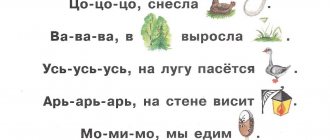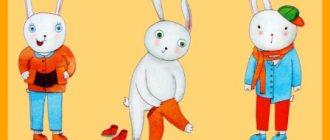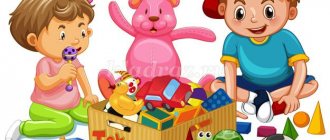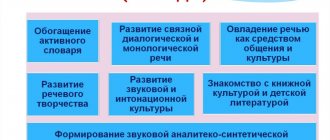DIY speech corner
A manual made with your own hands, supplemented, expanded to suit the needs of children and the goals of the lessons, will always be of much greater value and will make learning more effective and efficient.
In preschool age, the predominant type of activity is play, so the materials presented provide the opportunity to perform exercises in the form of a fun game that solves serious problems. The creation of the presented manuals allows children to independently or with the help of an adult perform exercises that develop fine motor skills,
phonemic hearing, as well as consolidate acquired knowledge in the classroom.
Didactic manual "House"
As you know, the development of speech is closely related to the development of fine motor skills, so speech corners are necessarily supplemented with the necessary aids for this: lacing, massage balls, su-jok balls, etc.
Boards for the development of fine motor skills are also found in speech therapy practice, but more often they are an open version, and if they have closed holes, then with the least functionality, because often only a picture follows the door, and besides, the open versions of such boards are less aesthetically pleasing. This “House” manual is made mostly of plywood to lighten the structure, and for strength and ease of fastening the parts with fasteners, stiffening ribs were used, and there are hooks on the back panel to securely fasten the manual to the wall. Closed elements add not only aesthetics to the manual and a surprise moment for the child, but also, among other things, allow you to save space, since various elements are located not on one long panel, but on two (external and internal), and the most functional one is neatly “hidden” " The manual attracts the child's interest and includes many different devices for the development of fine motor skills of a preschooler. “House” is a simulator for developing fine motor skills through various manipulations with a switch, socket, latch, lock, door chain, door hook, lids, and doorbell. The presented elements are interesting to the child because they are encountered in his life every day without a playful orientation. Here it is possible to carry out repeated manipulations without damaging household items, at the same time developing dexterity of the fingers, and the acquired muscle memory will be very relevant in everyday life. In addition, fine motor skills develop, and for children with speech pathology this is especially important (accuracy, speed and coordination of movements suffer, mainly in children with dysarthria). This means that speech develops indirectly and directly, because you can play not only on your own, training your fingers, but also with a teacher, pronouncing your actions, choosing the necessary antonym, listening and following instructions.
Didactic manual “Snail”
Speech therapy snails and their variants have become firmly established in the everyday use of speech therapists and educators in classes on speech development and automation of sound pronunciation.
My manual, having absorbed the positive qualities of such didactic materials, is distinguished by the natural raw materials from which it is made. In addition, the presence and sufficient number of medium-sized pockets, and this already solves the problem of selecting the necessary painting material without special material costs. Mobility, a variety of cards on lexical topics, and the ability to be included in individual and group lessons make this manual multifunctional. This didactic manual solves the following correctional and educational tasks: to teach to form generalizing concepts on various topics, to consolidate and expand the vocabulary on the same lexical topics.
Correction and development tasks:
- develop sound-letter analysis skills, generalization and systematization skills;
- automate the sounds in words;
- develop coherent speech skills through composing a story based on pictures.
Children happily fill out the “Snail” with pictures, naming them, correlating them with the topic of the lesson, while doing a small grammatical exercise (“name it affectionately”, “count to five”, “one-many”, “pick up a sign”).
Thus, in a lesson, this manual can be used at any stage: both as an organizational moment, and at the main stage, as an independent exercise, and at the final stage when summing up the results. This “Snail” serves as the basis for compiling a sequential story based on pictures, an addition to the familiarization and generalization of material on various lexical topics, and the consolidation of the given sounds in words in different positions. In this manual, picture material, which can be supplemented if desired, is selected not only for various lexical topics, but also for the following sounds in different positions (beginning, middle, end of the word): [р], [л], [ж], [ w], [h], [sch], [ts], [z], [s].
The games and exercises listed below are just a small example of how this manual can be used, because its main positive quality is its versatility of use in classes, both individual and group.
Games and exercises
— Exercise “Select pictures for a given sound.” Goal
: automate the delivered sound in words.
Objectives
: develop phonemic hearing; develop sound analysis skills.
— Exercise “Choose a picture with a given sound at the beginning, in the middle, at the end of the word.” Target
: automate the delivered sound in words in different positions.
Objectives
: develop sound analysis skills; develop phonemic hearing.
— Exercise “Choose a picture on a given topic.” Target
: consolidate words on the lexical topic being studied.
Objectives
: develop generalization and systematization skills; develop attention, memory, thinking.
— Exercise “Tell me according to the diagram.” Target
: to develop skills in writing a story using pictures.
Tasks
: consolidate words on the lexical topic being studied; develop the grammatical structure of speech through the coordination of words in a sentence; develop attention and memory.
Zhanna Glazkova, teacher-speech therapist, MADOU D/s No. 119 o.v. "The Nightingale", Magnitogorsk
Contents of speech corners in preschool groups. Material on speech development on the topic
Contents of speech corners in preschool groups.
1st junior group
1. Pictures on lexical topics.
2. Game catalog:
a) on the sound culture of speech; b) articulatory gymnastics exercises; c) breathing exercises; d) finger gymnastics.
3. Works of art according to the program, etc.
4. Verbal didactic games.
5. Pure sayings, poems, nursery rhymes, sayings, sentences.
6. Subject pictures.
7. Various types of theaters.
8. Pictures:
a) depicting natural phenomena; b) household items; c) main parts of transport (cabin, steering wheel, windows, doors, wheels); d) depicting the work of adults (the cook cooks, the nanny cleans, the mother sews); e) depicting the size, color, quality of objects (red, etc., clean-dirty, sweet-bitter, big-small, etc.); f) depicting actions (going to bed, sitting down, getting dressed, walking, sweeping, washing, ironing, etc.)
2nd junior group
1. Pictures on lexical topics (albums).
2. Game catalog:
a) on the sound culture of speech; b) articulatory gymnastics exercises; c) breathing exercises; d) finger gymnastics.
3. Works of art according to the program, etc.
4. Verbal didactic games.
5. Pure sayings, poems, nursery rhymes, sayings, sentences.
6. Subject and plot pictures for composing descriptive stories.
7. Various types of theaters.
8. Pictures:
a) depicting the characteristic features of the seasons; b) household items; c) details of objects; d) depicting the work of adults (the cook cooks, the nanny cleans, the mother sews); e) depicting the size, color, quality of objects; f) depicting actions (going to bed, sitting down, getting dressed, walking, sweeping, washing, ironing, etc.).
Middle group
1. Pictures on lexical topics.
2. Game catalog:
a) on the sound culture of speech; b) articulatory gymnastics exercises; c) breathing exercises; d) finger gymnastics.
3. Works of art according to the program, etc.
4. Verbal didactic games.
5. Pure sayings, poems, nursery rhymes, sayings, sentences.
6. Subject and plot pictures for composing descriptive stories.
7. Various types of theaters.
8. Pictures:
a) depicting natural phenomena; b) household items; c) the main parts of objects; d) depicting the work of adults (the cook cooks, the nanny cleans, the mother sews); e) depicting the size, color, quality of objects (red, etc., clean-dirty, sweet-bitter, big-small, etc.); f) depicting actions (going to bed, sitting down, getting dressed, walking, sweeping, washing, ironing, etc.). e) with images of objects in the plural (one table - many tables, one doll - many dolls); g) to coordinate nouns with numerals (1st pear, 2nd pear, 5 pear
9. Mirror or customized mirrors.
Senior group
1. Pictures on lexical topics.
2. Game catalog:
a) on the sound culture of speech; b) articulatory gymnastics exercises; c) breathing exercises; d) finger gymnastics; e) games for the development of phonemic hearing (color designations of sounds).
3. Works of art according to the program, etc.
4. Verbal didactic games.
5. Pure sayings, poems, nursery rhymes, sayings, sentences.
6. Subject, subject pictures, series of subject pictures for composing stories.
7. Pictures:
a) depicting natural phenomena; b) pictures depicting professions (bricklayer, painter, carpenter, livestock breeder, agricultural workers, cutter, seamstress, military man, doctor, teacher; c) main parts of transport (cabin, steering wheel, windows, doors, wheels); d) depicting special-purpose equipment (crane, excavator, tractor, panel carrier, snow blower), electrical equipment (vacuum cleaner, vegetable cutter, electric meat grinder, mixer); e) with clearly defined characteristics of objects (light, dark, sweet, sour, bitter, sonorous, clean, dirty, durable, fragile, large, etc.); f) depicting actions (going to bed, sitting down, getting dressed, walking, sweeping, washing, ironing, etc.); g) with images of synonyms; h) with images of animals in the plural; i) depicting objects in the plural (1 pear, 2 pears, 5 pears); j) with the image of indeclinable nouns (coffee, coat, piano, cocoa)
8. Mirror or customized mirrors.
Preparatory group
1. Pictures on lexical topics.
2. Game catalog:
a) on the sound culture of speech; b) articulatory gymnastics exercises; c) breathing exercises; d) finger gymnastics; e) games for the development of phonemic hearing (color designations of sounds).
3. Works of art according to the program, etc.
4. Verbal didactic games.
5. Pure sayings, poems, nursery rhymes, sayings, sentences.
6. Subject, subject pictures, series of subject pictures for composing stories.
7. Pictures:
a) depicting natural phenomena; b) pictures depicting professions (bricklayer, painter, carpenter, livestock breeder, agricultural workers, cutter, seamstress, military man, doctor, teacher; c) main parts of transport (cabin, steering wheel, windows, doors, wheels); d) depicting special-purpose equipment (crane, excavator, tractor, panel carrier, snow blower), electrical equipment (vacuum cleaner, vegetable cutter, electric meat grinder, mixer); e) with clearly defined characteristics of objects (light, dark, sweet, sour, bitter, sonorous, clean, dirty, durable, fragile, large, etc.); f) depicting actions (going to bed, sitting down, getting dressed, walking, sweeping, washing, ironing, etc.); g) with images of synonyms; 8. Mirror or customized mirrors.





